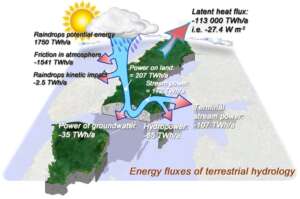Climate adaptation of large-scale hydropower systems under environmental constraints
Background
The viability of a fully renewable energy system depends on long- and short-term climate fluctuations that can cause rapidly changing availability of energy sources and problems such as energy droughts. These problems require sufficient energy storage and electric transmission capacities to coordinate production over larger regions. Hydropower can offer such services to a renewable energy system, but stands for a relatively small share of the total renewable energy potential. Further, a dominating part of the energy storage capacity within hydropower is located in Scandinavia, which motivates a continental perspective on attractive technical solutions for a renewable electricity system in which hydropower can offer interesting services in terms of flexibility and storage.
The North Atlantic oscillation has shown to follow certain periodic patterns, which result in alternatingly cold-dry and wet-warm weather in northern and southern Europe, respectively. These variations as well as other climatic, oscillatory phenomena affect not only the fluctuations in hydropower potential, but also all other renewables are affected because of the covariation between the hydro-climatic variables, especially the energy levels in wind, solar and hydro. Consequently, Scandinavian hydropower may offer important energy storage capacity for balancing energy fluctuations. Also, the continental coordination of the electricity production can reduce the energy storage need and, hence, contribute to stability of the electricity system. These climate related and environmental connections between energy sources calls for an intertwined view on the role of hydropower for the renewable energy system.
Aims
The overall aims of the project is to assess the large-scale spatio-temporal characteristics of the renewable energy components and to define the potential role of hydropower for balancing short- and long-term fluctuations in renewable energy availability. Sub-aims include to determine the climatic control on historic fluctuations and to statistically define how the European hydropower system can potentially be used as a compensatory resource in combination with appropriate technical solutions for electric transmission and development of management (production optimization) models.
Approaches
The research group is exploiting available data bases covering historic records of hydro-climatic data, developing an innovative spectral method for energy system analysis, developing multiple-objective management models for energy systems, and performing large-scale applications of before mentioned approaches.
Links
Links to previous journal papers on a) climate adaptation of hydropower systems, b) effects of regulation of rivers on floods and groundwater responses and c) environmental effects of hydropower regulated rivers:
Hydrograph variances over different timescales in hydropower production networks
Change in streamflow response in unregulated catchments in Sweden over the last century
Changes in short term river flow regulation and hydropeaking in Nordic rivers
Relation Between the North-Atlantic Oscillation and Hydroclimatic Conditions in Mediterranean Areas
Analysis of 220 Years of Floodplain Population Dynamics in the US at Different Spatial Scales
Trade-Offs between Phosphorous Discharge and Hydropower Production Using Reservoir Regulation
A power market-based operation support model for sub-daily hydropower regulation practices
Spectral Analysis of River Resistance and Aquifer Diffusivity in a River‐Confined Aquifer System
Mechanism of the progressive failure of non-cohesive natural dam slopes
Project leaders
Prof. Anders Wörman*
Assoc. Prof. Luigia Brandimarte*
Assoc. Prof. Joakim Riml*
Doctoral Students Shuang Hao* and Joel Axelsson*
*Division of River Engineering
Other funding agencies
Energimyndigheten:
- Långsiktiga prognoser av vind- och vattenkrafttillgång i ett fluktuerande klimat – Betydelse för produktionsplanering och investeringar i energilager och kraftöverföring, Dnr 2018-003815
- Den småskaliga vattenkraftens betydelse för det framtida svenska elsystemet, Dnr 2019-005552 (Projektledare är Mikael Amelin, Elkraftteknik, KTH)
Energy fluxes of terrestrial hydrology evaluated over the land surface of Sweden, red arrows representing energy transformation within the hydrological cycle. Hydropower currently “consumes” about one third of the available annual potential (J. Hydrol., 2016; The power of runoff; Copyright: Elsevier)

